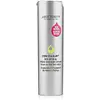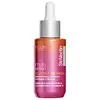What's inside
What's inside
 Key Ingredients
Key Ingredients

 Benefits
Benefits

 Concerns
Concerns

 Ingredients Side-by-side
Ingredients Side-by-side

Vitis Vinifera
MaskingAloe Barbadensis Leaf Juice
Skin ConditioningPyrus Malus Juice
Skin ConditioningGlycerin
HumectantSimmondsia Chinensis Seed Oil
EmollientGlyceryl Stearate
EmollientStearic Acid
CleansingHelianthus Annuus Seed Oil
EmollientGlyceryl Stearate Citrate
EmollientCoconut Alkanes
EmollientCoco-Caprylate
EmollientBidens Pilosa Extract
HumectantGossypium Herbaceum Seed Oil
Skin ConditioningLinum Usitatissimum Seed Oil
PerfumingRetinol
Skin ConditioningOenothera Biennis Oil
EmollientButyrospermum Parkii Butter
Skin ConditioningTocopherol
AntioxidantMalus Domestica Fruit Cell Culture Extract
Skin ConditioningVitis Vinifera Fruit Cell Extract
Skin ConditioningAcetyl Hexapeptide-8
HumectantCetyl Alcohol
EmollientMagnesium Ascorbyl Phosphate
AntioxidantStearyl Alcohol
EmollientDiheptyl Succinate
EmollientCitrus Limon Leaf Extract
PerfumingUbiquinone
AntioxidantCapryloyl Glycerin
Caprylyl Glycol
EmollientPolyglyceryl-6 Distearate
EmulsifyingEthylhexylglycerin
Skin ConditioningXanthan Gum
EmulsifyingPanthenol
Skin ConditioningAllantoin
Skin ConditioningCamellia Sinensis Extract
AntioxidantThioctic Acid
AntioxidantSodium Hyaluronate
HumectantMica
Cosmetic ColorantTitanium Dioxide
Cosmetic ColorantCinnamomum Camphora Wood Oil
MaskingLitsea Cubeba Fruit Oil
MaskingVitis Vinifera, Aloe Barbadensis Leaf Juice, Pyrus Malus Juice, Glycerin, Simmondsia Chinensis Seed Oil, Glyceryl Stearate, Stearic Acid, Helianthus Annuus Seed Oil, Glyceryl Stearate Citrate, Coconut Alkanes, Coco-Caprylate, Bidens Pilosa Extract, Gossypium Herbaceum Seed Oil, Linum Usitatissimum Seed Oil, Retinol, Oenothera Biennis Oil, Butyrospermum Parkii Butter, Tocopherol, Malus Domestica Fruit Cell Culture Extract, Vitis Vinifera Fruit Cell Extract, Acetyl Hexapeptide-8, Cetyl Alcohol, Magnesium Ascorbyl Phosphate, Stearyl Alcohol, Diheptyl Succinate, Citrus Limon Leaf Extract, Ubiquinone, Capryloyl Glycerin, Caprylyl Glycol, Polyglyceryl-6 Distearate, Ethylhexylglycerin, Xanthan Gum, Panthenol, Allantoin, Camellia Sinensis Extract, Thioctic Acid, Sodium Hyaluronate, Mica, Titanium Dioxide, Cinnamomum Camphora Wood Oil, Litsea Cubeba Fruit Oil
Water
Skin ConditioningSodium Ascorbyl Phosphate
AntioxidantGlycereth-7 Triacetate
EmollientPentylene Glycol
Skin ConditioningPolysorbate 20
EmulsifyingDipropylene Glycol
HumectantGlycerin
HumectantDimethyl Isosorbide
SolventAscorbyl Glucoside
AntioxidantAscorbic Acid
AntioxidantMalpighia Glabra Fruit Juice
Skin ConditioningRetinol
Skin ConditioningSodium Hyaluronate
HumectantMyristyl Nicotinate
Skin ConditioningTamarindus Indica Seed Polysaccharide
Skin ConditioningOrobanche Rapum Extract
Skin ProtectingMalus Domestica Fruit Cell Culture Extract
Skin ConditioningCamellia Sinensis Leaf Extract
AntimicrobialXylitylglucoside
HumectantBacillus/Sea Salt Ferment Filtrate
Skin ConditioningHydroxymethoxyphenyl Decanone
Skin ConditioningAnhydroxylitol
HumectantAdenosine
Skin ConditioningXylitol
HumectantGlucose
HumectantEthylhexylglycerin
Skin ConditioningLecithin
EmollientXanthan Gum
EmulsifyingAcrylates/C10-30 Alkyl Acrylate Crosspolymer
Emulsion StabilisingPropanediol
SolventMaltodextrin
AbsorbentRhizobian Gum
Mica
Cosmetic ColorantParfum
MaskingLimonene
PerfumingLinalool
PerfumingGeraniol
PerfumingCitral
PerfumingCitronellol
PerfumingBenzyl Benzoate
AntimicrobialChlorphenesin
AntimicrobialPhenoxyethanol
PreservativeBHT
AntioxidantBHA
AntioxidantSodium Benzoate
MaskingPotassium Sorbate
PreservativeCI 77491
Cosmetic ColorantCI 77891
Cosmetic ColorantWater, Sodium Ascorbyl Phosphate, Glycereth-7 Triacetate, Pentylene Glycol, Polysorbate 20, Dipropylene Glycol, Glycerin, Dimethyl Isosorbide, Ascorbyl Glucoside, Ascorbic Acid, Malpighia Glabra Fruit Juice, Retinol, Sodium Hyaluronate, Myristyl Nicotinate, Tamarindus Indica Seed Polysaccharide, Orobanche Rapum Extract, Malus Domestica Fruit Cell Culture Extract, Camellia Sinensis Leaf Extract, Xylitylglucoside, Bacillus/Sea Salt Ferment Filtrate, Hydroxymethoxyphenyl Decanone, Anhydroxylitol, Adenosine, Xylitol, Glucose, Ethylhexylglycerin, Lecithin, Xanthan Gum, Acrylates/C10-30 Alkyl Acrylate Crosspolymer, Propanediol, Maltodextrin, Rhizobian Gum, Mica, Parfum, Limonene, Linalool, Geraniol, Citral, Citronellol, Benzyl Benzoate, Chlorphenesin, Phenoxyethanol, BHT, BHA, Sodium Benzoate, Potassium Sorbate, CI 77491, CI 77891
Ingredients Explained
These ingredients are found in both products.
Ingredients higher up in an ingredient list are typically present in a larger amount.
Ethylhexylglycerin (we can't pronounce this either) is commonly used as a preservative and skin softener. It is derived from glyceryl.
You might see Ethylhexylglycerin often paired with other preservatives such as phenoxyethanol. Ethylhexylglycerin has been found to increase the effectiveness of these other preservatives.
Glycerin is already naturally found in your skin. It helps moisturize and protect your skin.
A study from 2016 found glycerin to be more effective as a humectant than AHAs and hyaluronic acid.
As a humectant, it helps the skin stay hydrated by pulling moisture to your skin. The low molecular weight of glycerin allows it to pull moisture into the deeper layers of your skin.
Hydrated skin improves your skin barrier; Your skin barrier helps protect against irritants and bacteria.
Glycerin has also been found to have antimicrobial and antiviral properties. Due to these properties, glycerin is often used in wound and burn treatments.
In cosmetics, glycerin is usually derived from plants such as soybean or palm. However, it can also be sourced from animals, such as tallow or animal fat.
This ingredient is organic, colorless, odorless, and non-toxic.
Glycerin is the name for this ingredient in American English. British English uses Glycerol/Glycerine.
Learn more about GlycerinThis ingredient comes from a rare Swiss apple known as Uttwiler Spätlauber. It is produced from the cell cultures of the apple and not the fruit itself.
According to manufacturer studies, this ingredient has demonstrated the following benefits:
- Visible anti-wrinkle effect around the eye area (in vivo)
- Enhanced colony-forming efficiency of epidermal stem cells (in vitro)
- Improved ability of skin cells to regenerate and build new tissues in a 3D epidermis model (in vitro)
- Increased skin density (in vitro)
- Boosted vitality of epidermal stem cells (in vitro)
- Reversal of cellular aging signs in fibroblasts (in vitro)
Mica is a naturally occurring mineral used to add shimmer and color in cosmetics. It can also help improve the texture of a product or give it an opaque, white/silver color.
Serecite is the name for very fine but ragged grains of mica.
This ingredient is often coated with metal oxides like titanium dioxide. Trace amounts of heavy metals may be found in mica, but these metals are not harmful in our personal products.
Mica has been used since prehistoric times throughout the world. Ancient Egyptian, Indian, Greek, Roman, Aztec, and Chinese civilizations have used mica.
Learn more about MicaRetinol is a gold-standard ingredient for anti-aging. It is a form of Vitamin A and belongs to the class of retinoids that also includes tretinoin.
Why is retinol famous?
It has the most scientific studies backing up its skin benefits out of all the non-prescription ingredients.
Retinol is proven to:
This is why retinol is effective at removing wrinkles, fading dark spots, treating acne, and reducing the appearance of pores.
Studies show retinol is less effective when exposed to UV. Be sure to look for appropriate packaging to keep your retinol potent (similar to Vitamin C).
Using retinol or any retinoids will increase sun-sensitivity in the first few months. Though studies show retinoids increase your skin's natural SPF with continuous use, it is best to always wear sunscreen and sun-protection.
We recommend speaking with a medical professional about using this ingredient during pregnancy.
Retinol may cause irritation in some people, so be sure to patch test. Experts recommend 'ramping up' retinol use: start using this ingredient once a week and work up to using it daily.
Read about Tretinoin
Learn more about RetinolSodium Hyaluronate is hyaluronic acid's salt form. It is commonly derived from the sodium salt of hyaluronic acid.
Like hyaluronic acid, it is great at holding water and acts as a humectant. This makes it a great skin hydrating ingredient.
Sodium Hyaluronate is naturally occurring in our bodies and is mostly found in eye fluid and joints.
These are some other common types of Hyaluronic Acid:
Learn more about Sodium HyaluronateXanthan gum is used as a stabilizer and thickener within cosmetic products. It helps give products a sticky, thick feeling - preventing them from being too runny.
On the technical side of things, xanthan gum is a polysaccharide - a combination consisting of multiple sugar molecules bonded together.
Xanthan gum is a pretty common and great ingredient. It is a natural, non-toxic, non-irritating ingredient that is also commonly used in food products.
Learn more about Xanthan Gum